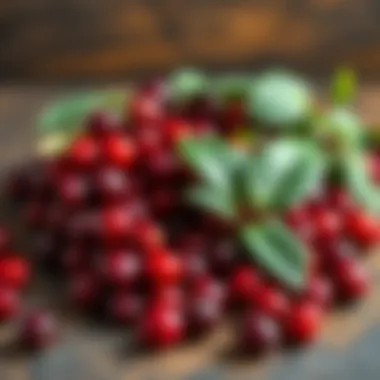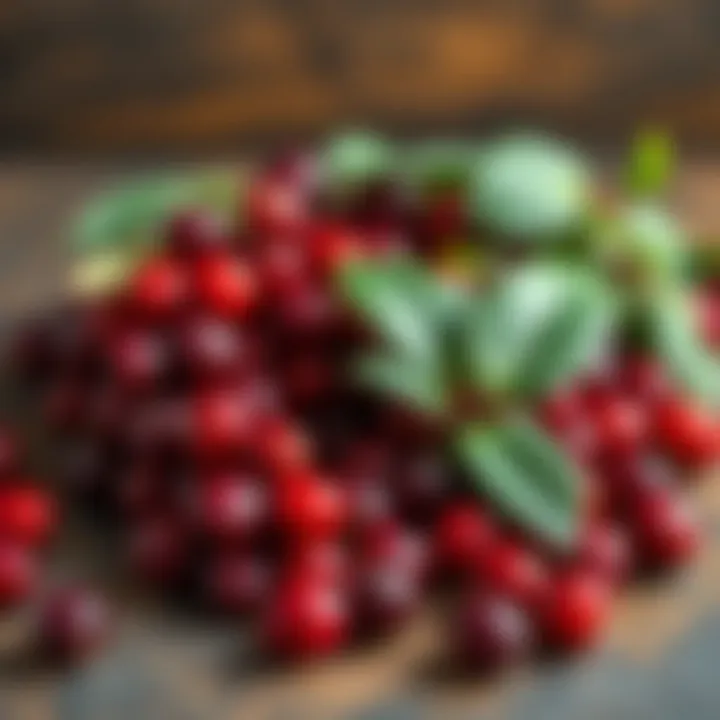Regular Cranberry Juice: Nutritional Insights and Benefits


Intro
Cranberry juice has long held a place in both culinary and medicinal traditions, but it’s often shrouded in a cloak of confusion and misunderstanding. Whether you’re sipping it at brunch, using it in a cocktail, or considering its health benefits, the world of cranberry juice is layered with depth. This exploration will guide you through its intricate landscape—from the basic ingredients to its varied uses in the kitchen and its role in health. You might be surprised to learn how much this humble juice can offer.
Ingredients Breakdown
Understanding the ingredients that make up regular cranberry juice is crucial for appreciating its value and flavor. Here’s a closer look at what goes into crafting this juice.
Primary Ingredients
- Cranberries: The star of the show, these small, tart berries are packed with antioxidants and vitamins.
- Water: A basic component that helps dilute the juice for drinkability without overwhelming the palate.
- Sugar: Often added to balance the tartness of the cranberries. The type and amount can vary based on brand and personal preference.
Optional Ingredients
- Citrus Juices: Commonly, orange or lemon juice is added to enrich flavor. This citrus kick can elevate the overall taste profile.
- Flavorings: Some brands infuse additional flavors such as vanilla or spices like cinnamon, although this is less common in regular cranberry juice.
Essential Kitchen Tools
To get started on your cranberry juice journey, it’s helpful to have a few kitchen essentials:
- Juicer or Blender: For those who want to make fresh juice from whole cranberries.
- Fine Mesh Strainer: Essential for separating the juice from the pulp if you’re preparing it yourself.
- Measuring Cups: Useful for determining the right balance of ingredients, especially if incorporating sweeteners or additional flavors.
Step-by-Step Preparation
For those interested in crafting their own cranberry juice, understanding the preparation methods can be invaluable.
Prepping the Ingredients
Start by rinsing fresh cranberries thoroughly. Discard any that are mushy or bruised, as these can alter the flavor negatively. If you’re using frozen cranberries, they can be used directly without thawing.
Cooking Techniques and Methods
- Boiling: Combine cranberries and water in a pot. For every cup of cranberries, add about 4 cups of water. Bring to a boil and let it simmer until the berries burst, which typically takes about 10-15 minutes.
- Blending: If using a blender, combine rinsed cranberries with a little water to help with blending, aiming for a smooth consistency.
Assembly and Presentation Tips
Once done, strain the liquid to separate the juice from the solids. Serve chilled, or mix into cocktails or vinaigrettes for a delightful twist. Presentation can also be jazzed up with fresh cranberry garnishes or even a sprig of mint.
Dietary Considerations
Cranberry juice does not just taste good; it can also align with various dietary preferences when selected wisely.
Gluten-Free Options
Cranberry juice is naturally gluten-free. However, ensuring that there are no added ingredients that might contain gluten, especially in processed varieties, is key.
Vegetarian and Vegan Substitutes
Most cranberry juices are vegan-friendly, just be cautious about any honey or animal-derived additives that some brands might include.
Nutrition Facts & Nutritional Considerations
Cranberry juice offers a wealth of vitamins. A typical serving can provide a good dose of Vitamin C and antioxidants, but it’s also laden with sugar, especially the sweetened versions. Always check labels to be informed on calories and “added sugar” to make better choices.
Variations and Customizations
Enhancing regular cranberry juice can transform it into a versatile ingredient in many dishes.
Flavor Enhancements
Consider adding a splash of seltzer for a refreshing fizz, or infusing some ginger for a zesty warmth.
Alternative Cooking Methods
For those with a penchant for experimentation, grilling or roasting cranberries before juicing can deepen their flavor, adding a unique twist.
Pairing Suggestions (Sides, Drinks, etc.)
Cranberry juice pairs beautifully with savory dishes, particularly those with rich flavors, like turkey or pork. It also makes for a delightful accompaniment to cheese platters, enhancing both sweet and savory notes.
Common Commonly Asked Questionss and Troubleshooting
Frequently Asked Questions
Q: Is cranberry juice effective for urinary health? A: Many people believe it helps prevent UTIs, as cranberry contains compounds that may impede the adherence of bacteria. However, more research is needed for definitive claims.
Common Mistakes to Avoid
One common pitfall is assuming not all cranberry juices are created equal. Brands can vary significantly in sugar content and overall quality, so it’s important to read labels carefully.
Solutions to Potential Problems
If your homemade juice turns out too tart, a touch of honey or a sprinkle of sugar can balance it nicely. Conversely, if it’s too sweet, a splash of lemon juice can help cut that sweetness.
Always be mindful of sourcing fresh, quality ingredients to ensure the best end product.
As we peel back the layers of cranberry juice and scrutinize its multifarious facets, it becomes clear that this simple beverage is filled with potential. Whether you’re after health benefits, culinary adventures, or simply a tasty drink, regular cranberry juice holds its own in any context.
Preface to Regular Cranberry Juice
Regular cranberry juice stands as a staple beverage for many, encapsulating more than just a tart flavor. This deep dive into its many aspects is particularly pertinent in today's climate where health consciousness and natural remedies are on the rise. The narrative surrounding cranberry juice is rich with history, cultural reverberations, and a plethora of health benefits that merit exploration.
It is not merely the taste that draws individuals in, but the robust nutritional profile and diverse culinary uses that make it an exceptional addition to any diet. More than that, understanding the production process, from farm to bottle, offers insights into the industry's practices, challenges, and the importance of sustainability. Being informed about these elements enables consumers to make better choices, not only for their own wellness but also for the environment. In a world where misinformation can run rampant, this analysis aims to shed light on the characteristics of regular cranberry juice and its significance in various contexts.
From a health standpoint, regular cranberry juice has been touted for its potential benefits, ranging from supporting urinary tract health to boosting the immune system. All these facets combined create a comprehensive picture, inviting food lovers and health enthusiasts alike to appreciate this ruby-red elixir.
Historical Significance of Cranberries


Cranberries have a storied past that hails back to Indigenous cultures in North America. Long before the arrival of European settlers, Native Americans utilized cranberries not only as a food source but also as a dye and even in medicinal practices. They called the fruit “sassamanesh,” and it was a part of their sustenance, cleverly integrated with other local ingredients.
As European settlers arrived, they quickly recognized the fruit's worth. The first recorded commercial cranberry harvest took place in the early 19th century in Massachusetts. Since then, this small berry has gone from being a wild forage to a cultivated crop, with the U.S. producing around 65% of the world’s cranberries today. Interestingly, the invention of the cranberry harvesting method using bogs revolutionized production, making it not only more efficient but also protecting the nutrient-rich fruit from spoilage. This transition reveals how ingenuity can blend with nature’s offerings, yielding careful craftsmanship in juice production today.
Cultural Impact and Usage
Cranberry juice has slithered its way into various kitchens and social practices across cultures. For many, it’s a staple at holiday feasts, known for its role in Thanksgiving dinners alongside turkey. But its reach extends far past the dinner table. In popular culture, cranberry juice is often associated with a healthy lifestyle, and it’s a common recommendation for those seeking to maintain urinary tract health. With its sharp flavor, it can balance sweeter cocktails, proving to be a versatile ingredient in mixology.
Moreover, the presence of cranberry juice in health food circles cannot be overlooked. People consume it for detox purposes, and fitness enthusiasts often include it in smoothies or as a post-workout refreshment. This widespread usage underlines how a simple fruit can transcend its geographical and culinary borders, morphing into an emblem of health across lifestyles.
"Cranberries are not just for the winter holidays; their impact reverberates through seasons and cultures alike."
Nutritional Overview
Understanding the nutritional profile of regular cranberry juice is pivotal in grasping the benefits it can bring to one’s health and culinary practices. This section will shed light on the vitamins, minerals, and other elements that make cranberry juice not just a refreshing drink but also a nutrient-dense component of a healthy diet. Knowledge of its composition allows consumers to make informed decisions about its inclusion in their diets.
Vitamin and Mineral Composition
Cranberry juice is not just a delightful sip of tartness; it boasts a noteworthy collection of vitamins and minerals that can enhance one’s overall health. Primarily, the juice contains Vitamin C, an antioxidant that protects the body against free radical damage. One cup can supply a significant portion of the daily recommended intake of this vitamin, promoting skin health and enhancing immune function.
Additionally, cranberry juice includes smaller amounts of other vital vitamins such as Vitamin E and Vitamin K, along with essential minerals like potassium and manganese. Potassium helps maintain healthy blood pressure levels, while manganese plays a role in bone formation and metabolism.
"A glass of cranberry juice may well be a small glass of health benefits, packed with vitamins that pack a punch!"
Antioxidant Properties
Cranberries are often touted for their high antioxidant content, predominantly due to compounds such as flavonoids and phenolic acids. These antioxidants are crucial as they help neutralize oxidative stress in the body, which, over time, can lead to chronic diseases. Research shows that cranberry juice, loaded with these beneficial compounds, can aid in reducing inflammation and promoting heart health.
Moreover, the antioxidants present in cranberry juice have been linked to improved vascular health. This means that an intake of cranberry juice can support blood flow and potentially lower the risk of conditions relating to cardiovascular disease. In a nutshell, sipping on cranberry juice could offer a robust defense against oxidative damage.
Caloric and Sugar Content
When considering any beverage, especially juices, caloric and sugar content is a focal point for many health-conscious individuals. Regular cranberry juice does contain natural sugars; however, it is often lower in calories compared to other fruit juices. Typically, a single serving of unsweetened cranberry juice has about 50 to 80 calories.
It's worth noting that cranberry juice's sweetness varies significantly based on how much added sugar is included, or if it’s sweetened with alternative sweeteners. It's advisable to choose unsweetened varieties when possible to maximize health benefits while keeping sugar intake in check.
Health Benefits
The segment on health benefits aims to shed light on how regular cranberry juice can play a vital role in enhancing well-being. Often touted for its numerous properties, this juice serves not just as a refreshing beverage, but as a natural remedy. In today’s fast-paced world, individuals are increasingly seeking reliable ways to improve their health with natural ingredients. Cranberry juice has made its case, particularly in its potential benefits for urinary tract health, cardiovascular support, and immune boosting. By delving deeper into these aspects, we gain a clearer understanding of how this juice impacts our health.
Urinary Tract Health
Cranberry juice has long been associated with urinary tract health, and this isn’t just folklore. Its primary component, proanthocyanidins, works against bacteria such as E. coli that can lead to infections. What’s remarkable is that these compounds prevent the bacteria from adhering to the bladder walls. A study published in The American Journal of Clinical Nutrition emphasized that regular consumption of cranberry juice can reduce the recurrence of urinary tract infections (UTIs) in women. Thus, for those prone to these infections, integrating cranberry juice into their daily routine might just be a fruitful decision.
"Cranberry juice is not a magic potion, but scientific studies do support its effectiveness in preventing UTIs."
It's recommended to consume pure cranberry juice—though not always the most palatable option due to its tartness—these health benefits are hard to ignore. Additionally, drinking cranberry juice can help enhance hydration, further supporting urinary health. However, people need to be cautious and ensure they are getting products with high concentrations of cranberry extract.
Cardiovascular Support
Next up on the health benefits list is cardiovascular support. Several studies have revealed that cranberry juice is not merely a tasty treat, but could also be a heart health champion. The antioxidants found in cranberries, particularly flavonoids, play a crucial role in supporting heart health. These antioxidants help to combat oxidative stress, a leading player in heart disease and related complications.
Regular intake of cranberry juice has been linked to lower levels of LDL (bad cholesterol) and increased HDL (good cholesterol), creating a favorable balance for cardiovascular health. A research piece from Nutrition Reviews suggested that those who regularly consume cranberry products have lower risks of cardiovascular diseases. However, moderation is key since too much sugar and calories can also backfire.
Incorporating cranberry juice into the diet might not just make for delicious beverages but can reflect positively on one's heart health in the long run. It might be wise to combine cranberry juice with other heart-friendly ingredients, like in smoothies or salad dressings.
Boosting the Immune System
Lastly, the immune-boosting properties of cranberry juice deserve attention. During the cold and flu seasons, a glass of cranberry juice could serve as a helpful ally. Rich in Vitamin C and other antioxidants, cranberry juice plays a pivotal role in enhancing immune function. These elements work as a shield, providing support against infections and illnesses.
Research indicates that cranberries can boost the production and activity of white blood cells, the body's frontline soldiers against pathogens. Regular consumption can contribute to a more robust immune response, promoting overall health. However, it's important to balance cranberry juice intake with a varied diet rich in various vitamins and minerals.
To sum it up, regular cranberry juice offers more than just delightful taste. Its benefits, ranging from urinary health to cardiovascular support and immune boosting, make it a worthwhile addition to one’s diet. While incorporating it into daily life, people should seek out quality products and balance their intake with a well-rounded diet.
Culinary Applications
Culinary applications of regular cranberry juice are incredibly diverse and hold great importance in both everyday cooking and elaborate cuisine. It not only serves as a refreshing beverage but also plays a crucial role in enhancing flavors as well as providing nutritional value. When used wisely, cranberry juice can elevate dishes from mundane to extraordinary. Its unique tartness and vibrant color complement a wide array of ingredients, making it a valuable addition to any kitchen pantry.
Pairing with Other Ingredients
Cranberry juice's versatility shines through when paired with other ingredients. The tartness cuts through rich and fatty elements in dishes like roasts or creamy sauces. For example, combining cranberry juice with orange juice creates a delightful citrus balance that works well as a marinade for poultry, adding depth while tenderizing the meat. Similarly, incorporating it into salads brings a refreshing zing that offsets heavy dressings.
- Pairing Suggestions:
- With proteins: Chicken, turkey, and pork are excellent companions to the bright notes of cranberry.
- With savory elements: Strong cheeses, nuts, and herbs like rosemary can accentuate the juice's flavor.
- Sweet complements: Pairs well with apple or pear in desserts, enhancing the natural sweetness without overwhelming it.
Recipes Featuring Cranberry Juice
Smoothies
Integrating cranberry juice into smoothies offers a burst of flavor while skirting the line between sweet and sour. This balance makes it an excellent option for health-conscious individuals looking for a refreshing drink that packs a punch. For one, smoothies that feature cranberry juice often boast bright reds that evoke a sense of freshness and vitality. However, smoothies can be tricky; too much cranberry can turn one’s breakfast into a lip-puckering experience. Thus, combining it with creamy elements like yogurt or bananas usually results in a more agreeable blend.
- A Simple Recipe:
- 1 cup cranberry juice
- 1 banana
- 1/2 cup Greek yogurt
- A handful of spinach (optional for health)
Marinades and Dressings
Cranberry juice shines when added to marinades and salad dressings, enhancing overall flavor while contributing acidity to tenderize meats. Its natural sugars caramelize during cooking, creating a lovely glaze. For instance, a cranberry-based dressing can turn a simple green salad into a symphony of flavors. Yet, with its tartness, one must be cautious with the amounts; striking the right balance leads to delightful culinary outcomes.
- Example Dressing:
- 1/4 cup cranberry juice
- 1/3 cup olive oil
- 2 tablespoons balsamic vinegar
- Salt and pepper to taste
Cocktails
Regular cranberry juice is a favorite among mixologists for its ability to balance spirits and other flavors. The juice’s tartness makes for an energizing cocktail base, providing a diverting twist to classic drinks. Be it a cosmopolitan or a festive punch, cranberry juice can amplify them all. As a bright red, it adds visual appeal, drawing attention even before the first sip. Just be wary of blending it with overly sweet components, which can mask its distinctive taste.
- Popular Cocktails:


- Cosmopolitan: Vodka, triple sec, cranberry juice, and lime make a classic.
- Cranberry Mimosas: A sparkling twist on brunch favorites using cranberry and champagne for a vibrant toast.
"Incorporating cranberry juice into your culinary repertoire can transform everyday meals into something noteworthy—both in taste and visual appeal."
Production Process
The production process of regular cranberry juice is vital for understanding how this tart beverage makes its way from the bogs to your glass. It influences the flavor, nutritional value, and overall quality of the juice, making it essential knowledge for enthusiasts and consumers alike. By examining how cranberries are harvested, juiced, and preserved, we can appreciate the intricacies involved in its creation and also grasp the importance of sustainability in the juice industry.
Harvesting Techniques
Harvesting cranberries is no casual affair; it requires precise techniques unique to the fruit's growth habits. Most cranberries grow in wetlands known as cranberry bogs, where they thrive in sandy, acidic soil. One common method for harvesting these bright red gems is the water harvesting technique, which many think makes the process look like a scene out of a nature documentary. In this method, bogs are flooded with water, allowing the buoyant cranberries to float to the surface. Workers then use specially designed equipment, known as "water reels," to corral the floating cranberries into collection areas.
Then, there’s the dry harvesting method, which is less common for juice production but still significant. This involves manually picking or using mechanical harvesters that gently shake the bushes so that ripe cranberries can fall into bins. Each method has its advantages and is chosen based on factors like the intended use of the berries and the harvest season.
Juicing and Filtration Methods
Once harvested, the next step is juicing the cranberries. The process itself is somewhat straightforward but can have a significant impact on the final product. Fresh cranberries are first cleaned, removing any debris or unripe berries. Generally, the fruit is then crushed, releasing its juices. This is followed by a pressing process where pressure is applied to extract as much juice as possible while minimizing loss of flavor.
Filtration is the next critical step. The raw juice often contains pulp and seeds that might not be desirable in the final product. To get a smooth cranberry juice, different filtration methods can be employed. Some producers opt for a coarse filter, while others may choose finer filters or methods like centrifugation. Each choice alters the texture and clarity of the juice, affecting both aesthetic appeal and mouthfeel.
Packaging and Preservation
Once the cranberry juice is extracted and filtered, it moves towards packaging—an important stage aimed at maintaining freshness and flavor. Common packaging choices include glass bottles, plastic containers, or cartons. Each material offers distinct benefits and drawbacks regarding shelf life and environmental impact. Glass, for example, is often favored for its inert properties, while plastics may be lighter and easier to transport but can have drawbacks in preservation.
Preservation methods are also crucial. Many fresh juices are pasteurized to eliminate harmful microorganisms, which extends shelf life significantly. Then there’s cold-pressed juice, a method gaining traction, which retains more nutrients by using lower temperatures and avoids potentially altering the juice's taste through heating. Furthermore, some brands focus on using natural preservatives, such as ascorbic acid, to prevent oxidation without compromising the juice’s integrity.
In summary, the entire production process of cranberry juice—from thoughtful harvesting by experienced hands to careful juicing and preservation—plays a significant role in determining its quality and taste. The intricacies of this process call for awareness about sustainability, which will resonate with consumers who are becoming increasingly environmentally conscious.
By understanding the production aspects of regular cranberry juice, we tap into a world of flavors and health benefits, all crafted with a level of respect for both the fruit and the environment.
Comparison with Alternative Juices
When it comes to fruit juices, consumers often find themselves in a quandary, faced with an array of choices. There’s a whole world of flavors out there, and this section aims to shine a light on regular cranberry juice in relation to some popular alternatives, namely apple juice, grape juice, and orange juice. Understanding these comparisons is essential for anyone considering their overall health, flavor preferences, and how different nutrients can play a role in unfolding culinary experiences.
Apple Juice
Apple juice is like that reliable friend who always shows up when needed. It’s sweet, widely recognized, and often the first choice for many. One key characteristic of apple juice is its high natural sugar content. This sweetness makes it appealing to kids and those with a sweet tooth, but it's essential to consider:
- Nutritional Profile: Unlike cranberry juice, which is low in sugar and calories, apple juice tends to have a higher caloric density. This means that while it can pack a punch of flavor, it also increases sugar intake.
- Health Benefits: Apple juice contains certain phytonutrients like quercetin that may protect against inflammation and heart disease, but it lacks the unique proanthocyanidins found in cranberry juice, which benefit urinary tract health.
- Taste: The flavor profile varies significantly; apple juice brings forth mild sweetness that can be overly simple compared to the tartness of cranberry juice.
Cranberry juice might not be to everyone's taste, but its health benefits give it a strong edge when the focus shifts from flavor to function.
Grape Juice
Grape juice, often marketed as a health beverage, offers a sweet and rich complexity that enthusiasts enjoy. However, it packs its own set of intricacies:
- Nutritional Insights: Grape juice is loaded with antioxidants, particularly flavonoids and resveratrol, which can be heart-healthy. That said, it often includes more sugar than cranberry juice, sometimes making it an unwise choice for those watching their intake.
- Comparative Analysis: While grape juice does offer specific antioxidants, it does not provide the same focused benefits for urinary health that cranberry juice does. This nutritional distinction can be pivotal for consumers focusing on specific health outcomes.
- Palate Preference: For those who enjoy sweeter beverages, grape juice may hit the spot, but for those seeking a lively alternative, the sharpness of cranberry may be far more enticing.
In a nutshell, while both juices can coexist pleasantly on a shelf, cranberry juice has a narrow but powerful focus on health benefits, particularly for women.
Orange Juice
Orange juice is perhaps the most mainstream option at breakfast tables worldwide. Its zesty flavor is invigorating, but it is essential to delve deeper:
- Vitamin C Champion: Orange juice shines with its high vitamin C content, promoting immune health. However, cranberry juice also brings other nutrients to the table without the excess calories and sugar that orange juice carries.
- Sugar Concerns: The sugar content in orange juice can be misleading. While it offers some health benefits, the spike in sugar can lead to energy crashes if consumed in excess. In contrast, cranberry juice holds its own because of its lower sugar levels and tart flavor that often leads to smaller portion sizes consumed.
- Flavor Dynamics: Comparing tastes, orange juice delivers brightness, whereas cranberry juice offers a balanced mix of sweet and tart that can boost various culinary applications, from cocktails to salads.
Ultimately, the choice between these juices hinges on personal preference and health objectives.
"Choosing the right juice isn’t just about taste; it’s about matching your goals and needs with what each option provides."
By equipping consumers with this knowledge, making an informed decision about juice can become less of a challenge. Understanding how regular cranberry juice distinctly measures up against its counterparts can help one make dietary choices aligned with both pleasure and health.
Common Misconceptions
Understanding the misconceptions surrounding regular cranberry juice is essential for consumers who wish to make informed decisions about their health and dietary choices. Many people hold incorrect beliefs that can impact how they view the benefits and potential drawbacks of this popular juice. Addressing these misconceptions not only clears up confusion but also highlights the true nature of cranberry juice and its actual health implications.
Sugar Content Myths
One of the most prevalent misconceptions concerns the sugar content of regular cranberry juice. Many folks think that cranberry juice is loaded with sugar and, consequently, unhealthy. While it’s true that some commercial varieties may contain added sugars, 100% cranberry juice is much lower in sugar than people assume.
- The natural berry has a tart flavor, which often leads to the belief that it must contain a high sugar level to counteract the tartness.
- When consumed in moderation, cranberry juice can fit nicely in a balanced diet. It provides beneficial nutrients without the excessive sugar found in other fruit juices.
It’s vital to read labels when choosing cranberry juice. Look for options that are labeled as 'unsweetened' or '100% juice' to cut through the clutter of marketing claims.
Always check the sugar content on the nutrition label. Not all juices are created equal!
Artificial Additives and Preservatives
Another area of concern for consumers is the fear of artificial additives and preservatives in cranberry juice. Some people shy away from this drink due to the assumption that it is packed with chemicals to enhance flavor, color, and shelf life. However, not all cranberry juice contains these additives.
- Many reputable brands focus on natural ingredients, producing juices that are free from artificial flavorings and colors. This provides health-conscious consumers with a more authentic drink.
- The processing of cranberries can vary between brands; hence, it’s essential for consumers to be vigilant about selecting products from companies that practice transparency in their ingredient sourcing and production methods.
By familiarizing oneself with the ingredients and production processes of cranberry juice, consumers can avoid unnecessary additives and enjoy a product that stays true to the wholesome nature of cranberries. This not only enhances the drinking experience but also aligns better with health-focused lifestyles.
In summary, dispelling myths about sugar content and additives helps paint a clearer picture of regular cranberry juice’s place in a healthy diet. Understanding the reality behind these misconceptions can empower consumers to make smarter choices that benefit their health and well-being.
Potential Risks and Considerations
When integrating regular cranberry juice into one’s daily routine, it’s essential to consider the associated risks and potential interactions, particularly with medications and the effects of excessive consumption. Understanding these factors ensures that the health benefits do not bring unforeseen consequences. Both casual drinkers and committed health enthusiasts should be aware of these nuances to maximize their enjoyment while minimizing any drawbacks.
Interactions with Medications
Cranberry juice is often celebrated for its health benefits, but it is crucial to recognize that it can interact with certain medications. A prominent concern is its potential to influence the effectiveness of blood thinners like warfarin. This interaction occurs because cranberry juice contains compounds that can alter how the body processes these medications. As a result, it may enhance the drug’s anticoagulant effects, leading to an increased risk of bleeding.
Beyond blood thinners, cranberry juice may also interfere with the metabolism of other drugs processed by the liver. Individuals taking prescription medications should consult with a healthcare professional prior to making cranberry juice a staple in their diet. A doctor can provide tailored advice, taking into account the specific medications being used, thereby ensuring safe consumption.
“Consultation with healthcare professionals is vital for ensuring safe usage, especially when undergoing treatment.”
Excessive Consumption Effects


While moderation is key, overindulgence in cranberry juice can lead to its own set of challenges. Drinking large quantities may provoke gastrointestinal issues such as diarrhea or stomach cramps. The high levels of fructose and sorbitol in cranberry juice can be hard on some individuals, particularly those with sensitive stomachs.
Furthermore, excessive sugar intake from sweetened cranberry juices can lead to unintended weight gain and other metabolic issues. For people monitoring their caloric or sugar intake, it’s wise to opt for unsweetened versions and to limit overall consumption. Keeping portion sizes in check ensures that one can enjoy cranberry juice without adverse consequences.
In summary, while regular cranberry juice can serve as a healthful addition to one’s diet, awareness of its potential risks is crucial. Engaging with healthcare professionals regarding medication interactions and being mindful of consumption levels can help individuals reap the benefits of this flavorful juice without falling into pitfalls.
Purchasing and Storage Recommendations
When diving into the realm of regular cranberry juice, understanding how to purchase and store it properly is crucial. Good cranberry juice offers a constellation of benefits that can only be fully realized when one chooses quality products and maintains their freshness. The marketplace is saturated with options; thus, discerning what’s worth your time and money can elevate your culinary experiences significantly.
Selecting Quality Products
Quality should never be an afterthought when it comes to selecting cranberry juice. Here are some key factors to consider:
- Look for 100% Juice: Many brands add water or sugar to their products, diluting the healthful properties. Always check the label for 100% cranberry juice.
- Review Ingredients: A short ingredient list is a good sign. Ideally, it should include only cranberries and perhaps a bit of natural juice from other fruits. Avoid any products loaded with preservatives or artificial additives.
- Check for Authentication: Some brands are certified organic or given seals from relevant health authorities. This indicates a commitment to quality and sustainable practices.
- Color and Clarity: High-quality cranberry juice generally displays a rich reddish hue but should not be overly cloudy. A little cloudiness may indicate that the juice has pulp, which can be a good sign. However, excessive cloudiness might signal poor filtering.
These discerning choices ensure that what you bring into your kitchen is not just an average drink but a powerhouse of health benefits.
Storage Tips for Freshness
Once you’ve secured that top-notch cranberry juice, how you store it can markedly impact its longevity and taste. Here are some practical tips to keep it fresh:
- Refrigerate Promptly: If the cranberry juice is fresh or has been opened, it should immediately be placed in the refrigerator. Temperature is key! A cold environment helps slow down the spoilage process.
- Seal Tightly: Always ensure that bottles or containers are tightly sealed to minimize exposure to air. Oxygen can cause the juice to lose its vibrant flavor and nutrients rapidly.
- Use Within a Reasonable Timeframe: Pay attention to the "drink by" dates. Even if it’s refrigerated, opened cranberry juice is best enjoyed within 5 to 7 days for optimal freshness and taste.
- Freezing as an Option: If you have a large quantity, consider freezing cranberry juice in ice cube trays. This method preserves its nutrients while allowing you to enjoy it in various recipes later.
"Cranberries are like nature’s thriving renegades, packed with vigor and flavor, but you have to be smart about safeguarding that goodness to truly reap the rewards."
Investing the time to select and store your cranberry juice properly can transform a simple beverage into an essential part of your health and culinary repertoire. By following these recommendations, you’ll ensure that every sip counts, complementing your meals and boosting your well-being.
Impact on Brand Development
The impact on brand development when it comes to regular cranberry juice is a pivotal topic within the beverage industry. Analysis of this segment sheds light on how consumers perceive products, and the ripple effects of these perceptions on marketing, sales, and overall business growth. Understanding these dynamics helps brands not only in establishing a foothold in a competitive market but also in fostering loyalty among their consumer base.
One key element is branding strategy. Regular cranberry juice, with its unique flavor and health benefits, provides a tremendous opportunity for companies to differentiate themselves. Brands that effectively highlight the nutritional advantages, such as rich antioxidants or benefits for urinary tract health, can position their products as essential for health-conscious consumers. This approach goes beyond traditional advertising; brands need to tell a story that resonates with their target audience, using various channels to convey their message.
Additionally, packaging plays a vital role in brand development. Eye-catching, functional packaging not only attracts attention on crowded supermarket shelves, but also communicates the brand's values around sustainability and health. A brand that opts for eco-friendly packaging might appeal to environmentally-conscious consumers while boosting its image.
"The essence of branding goes beyond aesthetic appeal; it’s about creating a connection with the consumer that lasts."
To harness marketing effectively, brands must be aware of the trends in consumer behavior surrounding cranberry juice. The rise of social media has changed how customers interact with brands. Feedback is immediate and public, meaning that a brand’s reputation can be built or shattered in mere hours. Engaging with consumers on platforms like Instagram or Facebook means brands must listen and adapt swiftly—responding to inquiries or criticisms in real-time. Brands that embrace this modern method of communication find themselves not only retaining customers but turning them into advocates.
In summary, impact on brand development for regular cranberry juice is multi-faceted, hinging largely on how well a brand can tell its story, connect with its audience, and respond to market trends. Embracing innovative marketing strategies and staying attuned to the evolving desires and expectations of consumers are the keys to long-term success in the competitive beverage landscape.
Marketing Strategies
Brands looking to capitalize on the cranberry juice market must develop comprehensive marketing strategies that resonate with their target demographic. One effective approach is emphasizing the health benefits of cranberry juice through targeted campaigns. For example, advertising initiatives that focus on how cranberry juice supports urinary tract health can reach a key market—health-conscious consumers. Recipes and usage ideas can also be shared on social media platforms, encouraging user engagement.
Utilizing digital marketing tools, like SEO, also aids in elevating a brand's online visibility. Brands can create content around trends and health benefits, integrating keywords related to cranberry juice. This can significantly help in directing traffic towards their website, tapping into the vast information-seeking population. Moreover, collaborations with influencers who advocate health and wellness can amplify a brand's reach. Their followers are likely a community seeking guidance and recommendations, making them valuable allies in spreading the word about cranberry juice.
Consumer Awareness Trends
Staying on top of consumer awareness trends is essential for brands in the cranberry juice sector. Recent shifts indicate a growing preference for transparency, with consumers increasingly demanding to know what’s in their juice and where it comes from. Brands that effectively communicate the sourcing of their cranberries and production practices can build trust with their audience.
Research indicates that consumers are becoming more thoughtful about their purchases, often opting for products that align with personal values. Brands can leverage this by spotlighting sustainability efforts or health-focused initiatives. The trend toward plant-based diets also highlights the increasing popularity of fruit juices as alternatives over sugary sodas or artificial drinks.
Sustainability and Environmental Considerations
Sustainability is not just a buzzword these days; it’s become a crucial conversation piece across industries. When it comes to regular cranberry juice, understanding the environmental considerations surrounding its production and sourcing plays a significant role in promoting eco-friendly practices. This section illuminates the relationship between cranberry cultivation and the planet’s wellbeing, reflecting on how consumers can make informed choices to support sustainable agriculture.
Sourcing Sustainably Grown Cranberries
Sourcing sustainably grown cranberries involves understanding the agricultural practices that minimize environmental impact. Many cranberry farmers are turning to methods that preserve soil quality, use less water, and avoid harmful chemicals. These practices contribute to maintaining a balanced ecosystem.
- Organic farming: This method avoids synthetic pesticides and fertilizers, focusing instead on natural alternatives. This means healthier cranberries for consumers and less environmental pollution.
- Water conservation: Cranberry bogs typically require significant water use, especially during the growing season. However, implementing water recycling techniques and efficient irrigation systems helps conserve water.
- Biodiversity: Integrating various crops into cranberry farming not only reduces pests but also encourages a more vibrant ecosystem. Farmer awareness about their surrounding environment can lead them to become stewards of the land rather than just nurturers of a singular crop.
Sourcing cranberries from these responsible growers ensures that consumers are supporting agricultural practices that positively impact both the environment and the community.
Waste Management Practices in Production
Once cranberries are harvested and processed into juice, waste management becomes a pressing concern. Sustainable waste management practices can significantly reduce the overall environmental footprint of cranberry juice production.
Implementing effective waste management strategies includes:
- Byproduct Utilization: The pulp leftover from juicing is often discarded, but it doesn't have to be. Innovative processors are finding ways to repurpose this byproduct into products such as cranberry powders, jams, or even natural fertilizers.
- Recycling: Large producers are increasingly adopting systems that recycle packaging materials, particularly plastics and glass. These efforts align with global recycling initiatives, promoting a circular economy.
- Sustainable packaging: Companies are now investing in eco-friendly packaging solutions, reducing their reliance on single-use plastics. Using materials that are biodegradable or recyclable helps lessen the burden on landfills.
Implementing robust waste management practices is a win-win situation. Not only does it reduce waste, but it also contributes to a more sustainable production cycle for cranberry juice. As consumers become more conscientious about their choices, the demand for sustainable practices in cranberry juice production only increases.
"The choices we make when purchasing products, like cranberry juice, can drive demand for sustainable agriculture and waste management practices."
By being mindful and opting for products that prioritize sustainability, consumers further empower growers to adopt practices that benefit both their health and the planet.
For those interested in further reading on these matters and the broader context of sustainable agriculture, consider exploring resources such as Wikipedia on Sustainability or university-led initiatives focusing on agricultural practices.
Closure
In evaluating the various facets of regular cranberry juice, it becomes clear that this once humble beverage holds a significant place in nutrition, health, and culinary landscape. The overarching theme of this article has been to shed light on the multifaceted nature of cranberry juice, revealing its far-reaching benefits and potential considerations.
Summarizing Key Points
To summarize, the exploration of regular cranberry juice encompasses several key areas:
- Nutritional Value: Rich in vitamins, minerals, and antioxidants, cranberry juice serves as a valuable addition to a balanced diet.
- Health Benefits: Known primarily for its role in urinary tract health, cranberry juice also supports heart health and bolsters the immune system, making it a drink of choice for many health-conscious individuals.
- Culinary Uses: The versatility of cranberry juice shines through in its ability to enhance cocktails, dressings, and even smoothies, widening its appeal beyond a simple beverage.
- Sustainability: The commitment to sourcing cranberries sustainably and responsibly is crucial for preserving the environment, ensuring that future generations can enjoy this valuable fruit.
- Market Trends: Understanding brand development and consumer trends provides a contextual backdrop for its popularity and availability in the market.
Future Directions and Research Opportunities
The journey into the world of cranberry juice is far from complete. Here are some avenues for future exploration:
- Emerging Research: Ongoing studies into the health benefits of cranberry juice could reveal new therapeutic potentials, especially concerning chronic conditions.
- Innovative Products: The development of functional beverages that leverage the health properties of cranberries could lead to exciting new products in the market.
- Consumer Education: More efforts can be put toward educating consumers about the true properties of cranberry juice, addressing misconceptions and emphasizing its versatile role in health and nutrition.
- Sustainable Practices: As climate change continues to be worrying, there’s a pressing need for innovations in sustainable practices in cranberry farming, which may involve new agricultural techniques to enhance yield while minimizing environmental impact.
As the research community, enterprises, and health advocacy groups continue to delve into these areas, the future of cranberry juice looks promising. There’s much to be learned, and its continued exploration could lead to better health outcomes for all.
"Cranberries are more than just a holiday treat; they're a key player in the nutrition world, rich in benefits but often overlooked in daily diets."
Further information can be found in the following resources:
- Wikipedia - Cranberry
- National Institutes of Health - Cranberries
- Cranberry Marketing Committee
- University Research Publications on Nutritional Benefits







